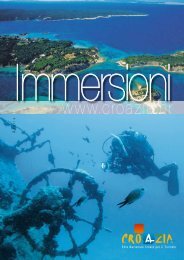Diving
Diving
Diving
Create successful ePaper yourself
Turn your PDF publications into a flip-book with our unique Google optimized e-Paper software.
The specific quality of the Zadar area lies in the beauty of its archipelago<br />
and its waters, which possess a wealth of walls, reefs and caves, often<br />
teeming with fish, particularly in the geological zone of the outer wall<br />
of the Kornati - a separate geological structure with a rich biological<br />
community named after the outer (western) side of the Kornati belt.<br />
Research has, however, found that it is a part of a single entity which<br />
extends northwards, across Dugi otok. Countless inclines, underwater<br />
crevasses, caves and the exceptional visibility of the submarine world of<br />
this area constitute an attraction of the Adriatic which has still not been<br />
fully realized. It must be pointed out, though, that many locations require<br />
either personal experience or supervision by an experienced guide from<br />
a diving centre, in other words the most attractive locations are often<br />
not suitable for solo diving by beginners. It happens quite frequently that<br />
divers, fresh from a diving course, drawn by the beauty and clarity of<br />
sea, exceed the limit of 20 m of depth, thereby exposing themselves to<br />
unnecessary risks.<br />
<strong>Diving</strong> within the area of the Telaščica Nature Park and the Kornati<br />
National Park is possible only with special permits, and it is accepted<br />
practice that diving excursions are organized through authorized diving<br />
centres based on the island of Murter and in the area extending from<br />
Biograd to Primošten. <strong>Diving</strong> locations are generally defined in advance<br />
in order to secure maximum safety during diving. Although the Kornati<br />
National Park is an area abounding with attractive diving locations, the<br />
fact that the entire archipelago, from Zadar to Šibenik, represents an<br />
almost indivisible, compact zone of attractions, prompts many divers<br />
to organize their diving excursions in almost all suitable micro-locations<br />
accompanied by professional guides from the surrounding diving centres<br />
who are completely familiar with the terrain.<br />
This area is not yet sufficiently covered by diving centres, and there still<br />
exist smaller centres, not readily accessible but located in the vicinity of<br />
attractive location, with a limited service capacity and a low growth rate<br />
per annum (islands of Pag and Dugi otok). It is to be expected that this<br />
area will undergo significant development following the completion of<br />
the motorway Zagreb–Dalmatia, which will ensure easier links between<br />
Dalmatia and the continental part of Europe.<br />
There are no large predators in the Adriatic, a fact which places the sea<br />
urchin close to the top of the list of dangerous creatures found in these waters<br />
∆<br />
∆ In locations frequented by divers, fish seem<br />
to be undisturbed in the company of their<br />
odd-looking visitors<br />
Croatian National Tourist Board 25




